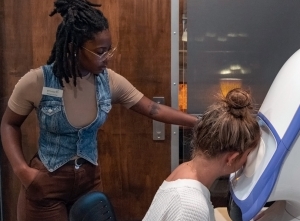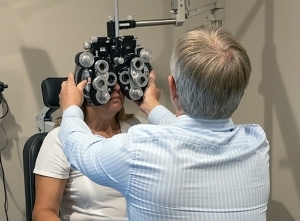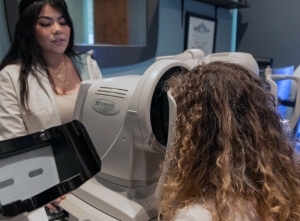Eyecare is important to your overall health!
We recognize that your sense of sight is precious; therefore, we approach all encounters from multiple perspectives to ensure that we’re providing the best possible care. With a proactive approach to eye health, our team of specialists is dedicated to providing exceptional products and services to our patients. Our commitment is to empower, advocate for, and educate our patients by the time they leave the door.
Many eye diseases are “silent killers.” They are not painful, nor do they cause an immediately noticeable reduction in vision. Instead they cause ongoing damage before the patient is aware there is a problem, and in many cases, there’s no way to repair the damage or restore your previous best vision. Early disease detection can save your vision and prolong the life you want to live. That’s why the early diagnosis and prevention of eye disease are our top priorities. Our goal is to preserve your eye health for a lifetime, allowing you to enjoy all of life’s experiences with the best eyesight.
Come visit us at Envision and see for yourself what a fun, honest, quality eyecare experience looks like!
It would be our privilege to be a part of your healthcare journey.
Common Eye Conditions
Age-Related Macular Degeneration
Although the cause is still unknown, age-related macular degeneration (AMD) leads to the loss of central vision. We advise proper nutrition and wearing sunglasses that filter UV (ultra-violet) and HEV (high-energy visible) light to reduce the risk of this sight-threatening condition that is becoming more common as the baby boomer population ages. In fact, AMD is the leading cause of blindness over the age of 55. We can often detect the early signs of AMD during a dilated vision eye exam and proactively preserve your best vision.
Glaucoma
People at a higher risk for glaucoma include those with a family history of the disease, strong spectacle prescriptions, diabetes and high blood pressure. Caused by an increase of pressure in the eye, called intraocular pressure, glaucoma begins with the loss of peripheral or side vision and can lead to loss of central vision and total blindness. Its most common forms are painless and go unnoticed until significant loss of vision occurs. That’s why it’s extremely important to schedule your annual eye exam to monitor eye pressure on a periodic basis. Half of the entire population with glaucoma is unaware they have the disease until irreversible damage has occurred. Fortunately, early detection can prevent vision loss.
For more information about eye diseases, treatment and prevention, go to the official American Optometric Association web site at www.aoa.org.
Sty and Chalazion
A sty is a painful red bump on your eyelid, usually on the outside part of your eyelid. It can occasionally occur on the inner portion of your eyelid. It is caused by an infection of the oil glands. A sty can cause pain, tearing, and swelling. If a sty does not improve after 48 hours, you should definitely see your eye doctor.
A chalazion occurs when there’s a blockage in one of the small oil glands at the edge of the eyelid, by the eyelashes. A chalazion usually isn’t painful, unlike a sty. A chalazion tends to be most prominent on the inner side of the eyelid.
Treatment for both eye conditions is similar. If swelling and redness spreads, see an eye doctor.
Eye Allergies & Dry Eye Syndrome
Allergies and dry eye are two of the most common eye conditions, both of which have been on the rise. Causes of these include increased pollution levels, medication side effects and changing hormonal levels. Fortunately, we have many new treatment options including holistic, preservative-free eye drops. Symptoms include dry, itchy, watery, red eyes that may feel gritty or as if there is something in your eyes. Left untreated, this can cause intermittent vision reduction and eye infection. In extremely severe cases, it can cause loss of vision. If you experience any of these symptoms, schedule an eye exam with us today.
Cataracts
Cataracts cause cloudy vision and lead to blindness. Although they can occur at any age, their typical onset is between the ages of 45 and 55, although symptoms may not become noticeable until 60 to 65. People who spend time outside without sunglasses – where they are exposed to UV (ultraviolet) and HEV (high energy visible) light – are more prone to developing cataracts. Cataracts can be delayed significantly by wearing sunglasses with UV/HEV filters. As they develop, cataracts cause a gradual, often unnoticed reduction in vision. Annual eye exams will enable our team to make appropriate recommendations and monitor changes to provide ongoing advice and treatment for your best vision and eye health.
Conjunctivitis or Pink Eye
Conjunctivitis is commonly known as “pink eye.” Pink eye gets its name because a classic symptom is that the whites of the eyes turn pink or red. There is often discharge, which can lead to crusting around the eyelids and lashes. The eyes can be itchy or feel scratchy. There are three different types of conjunctivitis including bacterial, allergic or viral. Treatment for conjunctivitis varies by type but may include eye drops or ointment. Viral and bacterial conjunctivitis can spread so take precautions such as regular hand-washing, avoiding touching your eyes, and avoiding sharing articles such as towels, eye makeup, contact lens cases, etc.



